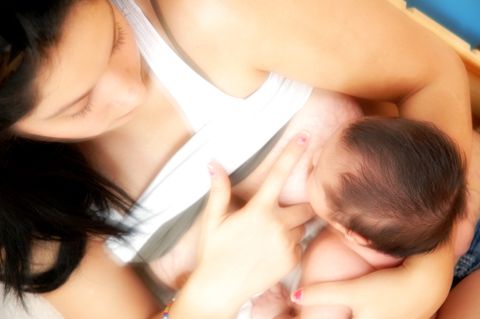How to Breastfeed a Baby - The Full Breastfeeding Guide
You should try to breastfeed your baby as soon as possible after birth. This will kick-start the release of hormones, that encourage milk production.

How to Breastfeed Successfully
Congratulations on deciding to breastfeed!
Breastfeeding is natural, but it does not always come naturally to the mother; it is an acquired skill, so do not think you are alone if you are struggling to breastfeed.
You need determination and breastfeeding information. Provided is the breastfeeding information, you will have to see to the determination!

Breastfeeding Class for Moms
Many mothers worry about breastfeeding not working for them, the pain and struggles associated with latching, and concerns about milk supply. The course tackles these fears head-on.
The course offers 13 easy-to-watch lessons, providing a step-by-step guide to breastfeeding.
The Breastfeeding Guide
Important breastfeeding tips and basics of breastfeeding...
- Sit in a relaxed atmosphere: If you have older children, get them something to keep themselves busy with. Relaxing will help your milk flow better.
- Positioning yourself and your baby: Pillows can be used for comfort, no matter which position you are breastfeeding in. They can be put behind your back, under your elbows, on your lap and put anywhere needed for the comfort of the two of you. When trying different breastfeeding positions, it always helps, if you are relaxed and supported well, with no strained muscles.

When learning how to breastfeed, hold your fingers around your breast for support, forming a U shape (as in the picture), but make sure you are not touching the areola (dark part around your nipple). Some mothers like to massage the milk out from their breasts while they are breastfeeding with breast compressions.
- Entice your baby onto the breast: Do this by rubbing your nipple gently over your baby’s cheek and lips. You can hand express a bit of milk and rub this onto your nipples; the smell of the breast milk will encourage your baby to nurse.
- Latching on “attaching your baby to your breast": Bring your baby in, so that he/she takes in a large part of the areola at the bottom of their mouth. Slightly flatten the end of your breast with your hands and gently, but firmly place your breast and part of the areola into your baby’s mouth. Your nipple should be where your baby’s soft palate is (further back in your baby’s mouth), if your nipple is at the hard palate, you will experience discomfort.
- Continue to hold your breast while your baby is breastfeeding, especially if your breasts are engorged, which is normal in the beginning.
- A bit of sensitivity, in the beginning, is normal; you can avoid sore nipples with a good latch. If the pain is too much, you should unlatch your baby and try again.
- Is there milk coming out? During the first few days following birth, you should not worry whether there is milk being produced. The little bit of colostrum (milky fluid secreted for the early days) is enough for your baby. Once the mature milk has "come in," you can start to look for signs of a good milk transfer. The baby’s jaw and ears will be moving if he/she is sucking efficiently and you should be able to see him/her swallowing. Learn more here... "is my baby getting in enough milk?"
- Burping: This can be done every 5 to 10 minutes during a breastfeeding session.
A few helpful links:
- Learn more about latching on here.
- Learn more about breastfeeding with large breasts and nipples.
- Learn more about breastfeeding with flat or inverted nipples.
The complete breastfeeding guide by Midwife and lactation consultant Kate Hale. Alternatively, opt for a Milkology breastfeeding course and equip yourself with the comprehensive knowledge necessary for a successful breastfeeding experience.


The Tushbaby Hip Carrier
With its ergonomic design and comfortable waistband, Tushbaby provides optimal support for you and your baby. Say goodbye to shoulder and back pain from traditional carriers, as Tushbaby evenly distributes your baby's weight, relieving strain and promoting better posture.
Breastfeeding Basics to Remember
- You should try to breastfeed your baby as soon as possible after birth. This will kick-start the release of hormones, that encourage milk production.
- Your baby’s body should be facing towards you while breastfeeding, and it is best if there is skin on skin contact. Kangaroo mother care is recommended.
- You should keep your baby at the level of your breast and should not be stretching/bending downward. This is to prevent backache.
- All of your nipple and a large amount of your areola should be found in your baby's mouth while breastfeeding. If your baby only latches onto the nipple, you may develop severe nipple pain.
- If you are feeling discouraged and your baby continues to cry, put your baby down and take a five-minute break before trying again.
- You will need to breastfeed your newborn baby, at least every two hours (some babies do breastfeed every hour) After about three weeks your baby will start to take longer stretches between feedings.
- To prevent sensitive nipples at the beginning of the breastfeeding relationship, you can avoid non-nutritive sucking while your baby is asleep. How can I keep my newborn baby awake while nursing?
- Getting your baby off of the breast: Just put your finger between the corner of your baby's mouth and your breast to break the suction.
- Breastfeeding help: Getting involved in a group where other mothers are also breastfeeding, will be a great help and a source of motivation.
- Alternate breasts by giving your baby the opposite breast every time he/she feeds. Pump your breasts after feedings, if you feel any engorgement. Do not time feedings at each breast.

Tips for Continued Breastfeeding
- Use a breastfeeding necklace if your baby is very distracted while nursing.
- Let your baby breastfeed on demand. Here are some cluster feeding and comfort nursing tips.
- You do not need to wean your baby when he/she starts to teethe. Here are tips on how to breastfeed a biting baby.
- Extended breastfeeding: Breastfeeding a toddler.
- Eat well, drink well and rest well.
- Do not supplement with formula or any other liquid, not even water; this will keep your own milk supply up. Breast milk is the only fluid a baby needs, unless if the mother has a low milk supply.
- Co-sleep with your baby at night.
- Do not give up! It gets easier as your baby grows.
